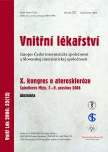Statins and osteoporosis
Authors:
P. Švejda
Authors‘ workplace:
I. interní klinika Lékařské fakulty MU a FN u sv. Anny, Brno, přednosta doc. MUDr. Miroslav Souček, CSc.
Published in:
Vnitř Lék 2006; 52(12): 1190-1193
Category:
Review
Overview
3-hydroxy-3-methylglutaryl coenzyme A reductase inhibitors, statins are potent inhibitors of cholesterol biosynthesis. Cholesterol-lowering therapy using statins significantly reduces the risk of coronary heart disease. Furthermore, wider use of statins leads to increases of other beneficial effects, so-called pleiotropic effects. These include reductions in cytotoxicity and inflammation reaction, oncoprotective effects – apoptosis of some types of cancer cells, improvement of endothel function, inhibition of thromb formation, decrease of the risk of dementia independent of improvement in the lipid spectrum, inibition of smooth muscle cells proliferation and inhibition of thrombocyte aggregation. One of the important effects is its influence on bone metabolism. Statins augment the expression of bone morphogenetic protein-2, a potent stimulator of osteoblast differentiation and its activity, and promote mineralization by cultured osteoblasts, indicating that statins have an anabolic effect on bone. The author has attempted to summarize the most recent theories on the mechanism of this effect and summarises studies that have been carried out, albeit with inconsistent results.
Key words:
statins – osteoporosis – bone density – risk of fracture
Sources
1. Alberts AW, Chen J, Kuron G et al. Mevinolin: a highly potent competitive inhibitor of hydroxymethylglutaryl-coenzyme A reductase and a cholesterol-lowering agent. Proc Natl Acad Sci USA 1980; 77: 3957-3961.
2. Bauer DC, Mundy GR, Jamal SA et al. Statin use, bone mass and fracture: an analysis of two prospective studies. J Bone Miner Res 1999; 14: S179.
3. Edwards CJ, Hart DJ, Spector TD et al. Oral statins and increased bone-mineral density in postmenopausal women. Lancet 2000; 355: 2218-2219.
4. Cummings SR, Black DM, Thompson DE et al. Effect of alendronate on risk of fracture in women with low bone density but without vertebral fractures: results from the Fracture Intervention Trial. JAMA 1998; 280: 2077-2082.
5. Hamelin BA, Turgeon J Hydrophilicity/lipophilicity: relevance for the pharmacology and clinical effects of HMG-CoA reductase inhibitors. Trends Pharmacol Sci 1998; 19: 26-37.
6. Chan KA, Andrade SE, Boles M et al. Inhibitors of hydroxymethylglutaryl-coenzyme A reductase and risk of fracture among older women. Lancet 2000; 355: 2185-2188.
7. Chung YS, Lee MD, Lee SK et al. HMG-CoA reductase inhibitors increase BMD in type 2 diabetes mellitus patients. J Clin Endocrinol Metab 2000; 85: 1137-1142.
8. Karpf DB, Shapiro DR, Seeman E et al. Prevention of nonvertebral fractures by alendronate: a meta-analysis. Alendronate Osteoporosis Treatment Study Group. JAMA 1997; 277: 1159-1164.
9. LaCroix AZ, Cauley JA, Jackson R et al. Does statin use reduce risk of fracture in postmenopausal women? Results from the Women's Health Initiative Observational Study (WHI-OS). J Bone Miner Res 2000; 15(Suppl 1): 1066.
10. Luckman SP, Hughes DE, Coxon FP et al. Nitrogencontaining bisphosphonates inhibit the mevalonate pathway and prevent post-translational prenylation of GTP-binding proteins, including Ras. J Bone Miner Res 1998; 13: 581-589.
11. McClung MR, Geusens P, Miller PD et al. Effect of risedronate on the risk of hip fracture in elderly women. Hip Intervention Program Study Group. N Engl J Med 2001; 344: 333-340.
12. Meier CR, Schlienger RG, Kraenzlin ME et al. HMG-CoA reductase inhibitors and the risk of fractures. JAMA 2000; 283: 3205-3210.
13. Meier CR, Schlienger RG, Kraenzlin ME et al. Statins and the risk of fracture. JAMA 2000; 284: 1921-1922.
14. Mundy G, Garrett R, Harris S et al. Stimulation of bone formation in vitro and in rodents by statins. Science 1999; 286: 1946-1949.
15. Pedersen TR, Kjekshus J Statin drugs and the risk of fracture. JAMA 2001; 284: 1921-1922.
16. Reid IR, Hague W, Emberson J et al. Effect of pravastatin on frequency of fracture in the LIPID study: secondary analysis of a randomised controlled trial. Lancet 2001; 357: 509-512.
17. Rogers MJ Statins: ower lipids and better bones? Nat Med 2000; 6: 21-23.
18. Van Beek E, Pieterman E, Cohen L et al. Farnesyl pyrophosphate synthase is the molecular target of nitrogen-containing bisphosphonates. Biochem Biophys Res Commun 1999; 264: 108-211.
19. Vogel G Cholesterol-lowering drugs may boost bones. Science 1999; 286: 1825-1826.
20. Wang PS, Solomon DH, Mogun H et al. HMG-CoA reductase inhibitors and the risk of hip fractures in elderly patients. JAMA 2000; 283: 3211-3216.
21. Watanabe S, Fukumoto S, Takeuchi Y et al. Effects of 1-year treatment with fluvastatin or pravastatin on bone. Am J Med 2001; 110: 584-587.
22. Zhang FL, Casey PJ. Protein prenylation: molecular mechanisms and functional consequences. Annu Rev Biochem 1996; 65: 241-269.
Labels
Diabetology Endocrinology Internal medicineArticle was published in
Internal Medicine

2006 Issue 12
Most read in this issue
- Statins and osteoporosis
- Ultrasound mapping of lower-limb vascular system with regard to occurrence and anatomy of additional front great saphenous vein
- Prospective use of EuroSCORE for the short−term risk evaluation of consecutive cardiac surgery candidates: are there any differences in prediction of perioperative risk versus risk of nonsurgical treatments?
- Collagenofibrotic glomerulopathy – rare glomerulonephritis
